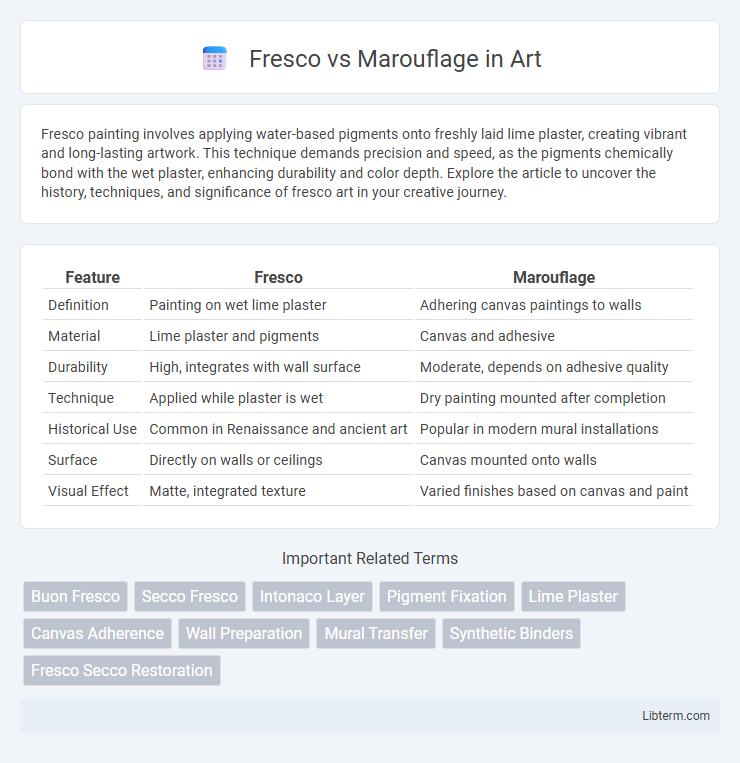Fresco painting involves applying water-based pigments onto freshly laid lime plaster, creating vibrant and long-lasting artwork. This technique demands precision and speed, as the pigments chemically bond with the wet plaster, enhancing durability and color depth. Explore the article to uncover the history, techniques, and significance of fresco art in your creative journey.
Table of Comparison
| Feature | Fresco | Marouflage |
|---|---|---|
| Definition | Painting on wet lime plaster | Adhering canvas paintings to walls |
| Material | Lime plaster and pigments | Canvas and adhesive |
| Durability | High, integrates with wall surface | Moderate, depends on adhesive quality |
| Technique | Applied while plaster is wet | Dry painting mounted after completion |
| Historical Use | Common in Renaissance and ancient art | Popular in modern mural installations |
| Surface | Directly on walls or ceilings | Canvas mounted onto walls |
| Visual Effect | Matte, integrated texture | Varied finishes based on canvas and paint |
Introduction to Fresco and Marouflage
Fresco is a traditional mural painting technique where pigments are applied onto wet lime plaster, allowing the colors to chemically bond with the wall surface for long-lasting durability. Marouflage involves adhering a painted canvas or artwork onto a solid surface such as a wall or panel using strong adhesives, enabling artworks to be prepared off-site and then installed. Both methods are prominent in mural art, with Fresco emphasizing direct application and permanence, while Marouflage offers flexibility in creation and installation.
Historical Background of Fresco
Fresco painting dates back to ancient civilizations such as the Minoans and Egyptians, with its peak during the Italian Renaissance when artists like Michelangelo perfected the technique on church ceilings. This method involves applying water-based pigments onto freshly laid wet plaster, allowing the paint to chemically bond with the wall surface for durability. Marouflage, by contrast, emerged later as a technique for adhering painted canvases onto walls, lacking the integral bond and long-standing history of fresco.
Origins and Evolution of Marouflage
Marouflage originated in ancient Egypt and gained prominence during the Renaissance as a technique for mounting paintings on walls using adhesives. Unlike fresco, which involves applying pigment to wet plaster, marouflage evolved as a method for affixing completed canvases to architectural surfaces, allowing for greater artistic flexibility. Over time, the use of marouflage expanded beyond murals to include restoration and preservation of large-scale artworks, cementing its role in art conservation.
Materials and Tools Used in Fresco
Fresco painting involves applying water-based pigments onto freshly laid lime plaster, requiring materials such as lime putty, sand, and natural pigments, along with tools like trowels, brushes, and sponges for smooth application and fine detailing. The plaster's chemical reaction with air causes the pigments to become an integral part of the wall surface, ensuring durability and vibrancy. In contrast, marouflage uses adhesives to affix painted canvas or paper to a wall, bypassing the chemical bonding process inherent in fresco techniques.
Techniques and Process of Marouflage
Marouflage is a technique that involves adhering a painted canvas to a wall or ceiling using a strong adhesive, allowing for large murals to be created off-site and then installed. This process differs from fresco, where pigment is applied directly onto wet plaster, requiring the artist to complete work quickly before the plaster dries. Marouflage offers greater flexibility in the painting process and durability during installation, making it suitable for detailed and large-scale works in controlled studio conditions.
Aesthetic Differences: Fresco vs Marouflage
Fresco enhances walls with vibrant colors absorbed into wet plaster, creating a matte, seamless surface that ages gracefully. Marouflage involves adhering painted canvases to walls, resulting in richer textures and the option for detailed brushwork that preserves vividness over time. The aesthetic difference lies in fresco's organic integration with architecture versus marouflage's capacity for intricate detail and versatility in finish.
Durability and Preservation Issues
Fresco painting, created by applying pigments onto wet plaster, offers superior durability due to the chemical bond formed as the plaster sets, resulting in long-lasting artwork resistant to fading and environmental damage. Marouflage involves adhering a painted canvas to a wall, which is less durable as it is prone to peeling, cracking, and damage from fluctuations in humidity and temperature. Preservation issues with frescoes often focus on moisture control and structural stability, while marouflage requires careful support and protection from physical wear and environmental factors to prevent deterioration.
Typical Applications and Artistic Uses
Fresco technique, commonly applied on wet plaster walls, is ideal for creating durable murals in churches, public buildings, and historic architecture, offering vibrant colors that integrate with the wall surface. Marouflage involves adhering painted canvases onto walls or panels, frequently used for transporting and preserving artworks in museums, theaters, and galleries with flexible display requirements. Both methods serve distinct artistic purposes: frescoes emphasizing permanence and integration with architecture, while marouflage supports portability and restoration of large-scale paintings.
Pros and Cons: Comparing Fresco and Marouflage
Fresco offers vibrant, long-lasting colors due to pigment absorption into wet plaster, making it highly durable and resistant to fading but requires skilled artists and precise timing, limiting flexibility. Marouflage allows for detailed artwork created on canvas to be adhered to walls, enabling easier corrections and faster installation, though it may be less durable over time and prone to peeling or environmental damage. Choosing between fresco and marouflage depends on priorities like permanence versus convenience and artistic control.
Choosing the Right Technique for Your Project
Selecting between fresco and marouflage depends on the surface and desired durability; fresco requires wet plaster applications on walls, ensuring longevity through chemical bonding, ideal for architectural integration. Marouflage, involving adhesive mounting of painted canvases onto walls, offers flexibility and portability, suited for projects needing intricate details or temporary installations. Evaluating environmental conditions, budget constraints, and artistic goals ensures the optimal mural technique for your project's success.
Fresco Infographic

 libterm.com
libterm.com